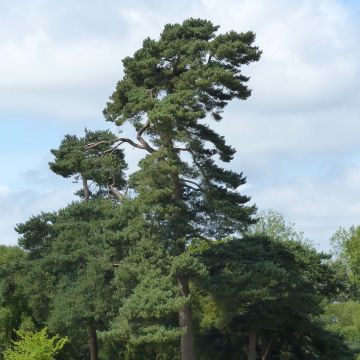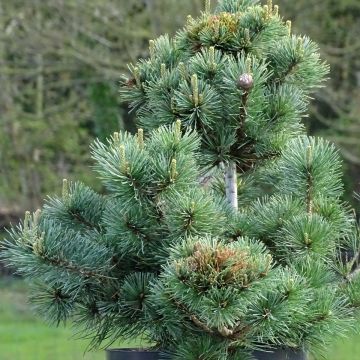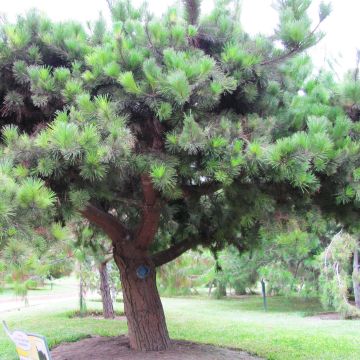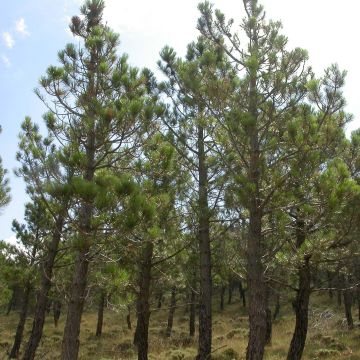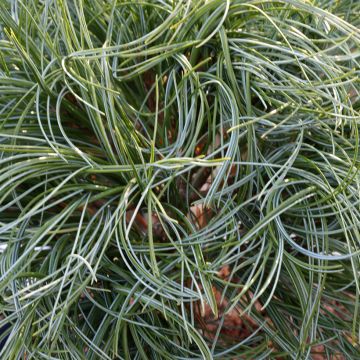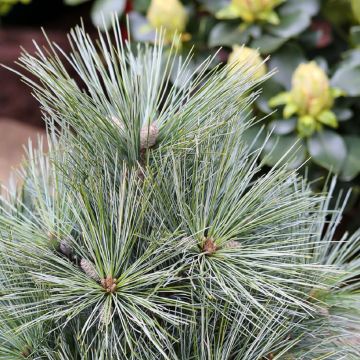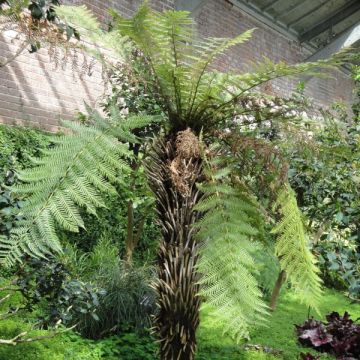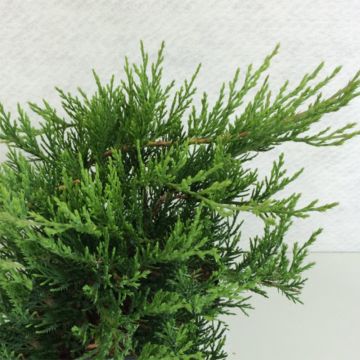Shipping country and language
Your country of residence may be:
Your country of residence is:
For a better user experience on our website, you can select:
Your shipping country:
Andorra
Austria
Belgium
Bulgaria
Canada
Chile
Croatia
Cyprus
Czechia
Denmark
Estonia
Finland
France
Germany
Greece
Hungary
Iceland
Ireland
Italy
Latvia
Lithuania
Luxembourg
Malta
Monaco
Netherlands
Poland
Portugal
Romania
Slovakia
Slovenia
Spain
Sweden
Switzerland
United Kingdom
We only deliver seed and bulb products to your country. If you add other products to your basket, they cannot be shipped.
Language:
French
German
Spanish
English
My Account
Hello
My wish lists
Plantfit
Log in / Register
Existing customer?
New customer?
Create an account to track your orders, access our customer service and, if you wish, make the most of our upcoming offers.


Pinus mugo Green Column - Pin de montagne
Pinus mugo Green Column - Dwarf Mountain Pine
Pinus mugo Green Column
Dwarf Mountain Pine, Swiss Mountain Pine, Mugo Pine
Why not try an alternative variety in stock?
View all →Order in the next for dispatch today!
Dispatch by letter from €3.90.
Delivery charge from €5.90 Oversize package delivery charge from €6.90.
More information
This item is not available in your country.
Schedule delivery date,
and select date in basket
This plant carries a 24 months recovery warranty
More information
We guarantee the quality of our plants for a full growing cycle, and will replace at our expense any plant that fails to recover under normal climatic and planting conditions.
From €5.90 for pickup delivery and €6.90 for home delivery
Express home delivery from €8.90.
Does this plant fit my garden?
Set up your Plantfit profile →
Description
Pinus mugo 'Green Column', of modest size, is an unusual form of mountain pine, still difficult to find in. It quickly forms a slender cone with a well-regulated habit. Its dense foliage hesitates between dark green and green-grey. Its ramified and ascending branches are densely covered with fairly long needles. Due to its modest growth, it is well suited for a small garden or a large rockery. It is an extremely hardy conifer that does not require pruning. It thrives in well-drained soil, even poor and chalky soil, and is happy in all exposures, including shade.
Pinus mugo, also known as Mountain Pine, Mugho Pine or Mountain Pine, is an evergreen conifer from the pine family endemic to the mountains of Europe. It is found in the subalpine zone, avoiding summer heat, from the Spanish sierras, through the high Alpine and Pyrenean massifs, to the Balkans. It only descends to an altitude of 200m (656ft) in Central Europe. In nature, it slowly reaches 3 to 4 metres (10 to 13 feet) in all directions, adopting a wind-swept silhouette that reflects its habitat. It is a very hardy species, well adapted to mountain climates.
The 'Green Column' variety distinguishes itself from the wild species with its compact, regular conical habit, and its adaptability to various conditions. Its growth is moderately fast, reaching a height of 2 metres (7 feet) and a spread of 1 metre (3 feet) at the age of 10. Ultimately, it will reach a height of 2.50 metres (8 feet) and occupy a diameter of 1.50 metres (5 feet) at ground level. Its branches are covered with fine needles, 4 to 5cm (2in) long, grouped in pairs and arranged in brushes. The young shoots, grouped in 3 to 5 at the end of 2-year-old branches, are green-grey. They emerge in spring from light brown and resinous buds, then take on a dark greyish-green colour. On its trunk, the bark is brown-grey, while it shows a green and glossy colour, then black, on the branches.
The 'Green Column' Mountain Pine will find its place in a small or medium-sized garden, alone, in a large rockery, as a hedge or on the edge of a woodland, or even in a woodland. As it grows well in shade, it can be placed against a grove, or its dark and elegant foliage can be used as a backdrop to highlight blooms or the lighter foliage of other dwarf conifers. It goes well with large stones, the geometric lines of swimming pools, and masonry structures. It can be combined with complementary grasses or with dwarf conifers with a prostrate habit (Juniperus horizontalis 'Blue Chip'), globose habit (Picea abies 'Little Gem'), or columnar habit (Juniperus communis 'Sentinel'). The true graphic qualities of conifers naturally impose themselves in the design of a contemporary garden, which prefers the aesthetics of forms, silhouettes, and textures over the dance of blooms. These plants, with their reassuring permanence, provide lasting structure to a bed, mark pathways, border terraces, easily replacing the strong presence of trimmed boxwood or holly. The key is to play with volumes and colours.
Pinus mugo Green Column - Dwarf Mountain Pine in pictures




Plant habit
Flowering
Foliage
Botanical data
Pinus
mugo
Green Column
Pinaceae
Dwarf Mountain Pine, Swiss Mountain Pine, Mugo Pine
Cultivar or hybrid
Other Pinus - Pine
Planting and care
Pinus mugo 'Green Column' can be planted from September to November and from February to June in well-drained soil, any type, even poor, whether it is limestone or, on the contrary, peaty and acidic. It only fears waterlogged soils and scorching temperatures. It grows well in any exposure and is not afraid of competition from the roots of other plants. Soak the root balls well before planting. Optionally, add organic amendment during planting and water generously in the first years, and in case of prolonged drought. You can apply a special conifer fertilizer every year in April and cultivate the soil in summer. This very hardy conifer (up to at least -30°C (1°F)) does not need to be pruned.
Planting period
Intended location
Care
This item has not been reviewed yet - be the first to leave a review about it.
Evergreen shrubs
Haven't found what you were looking for?
Hardiness is the lowest winter temperature a plant can endure without suffering serious damage or even dying. However, hardiness is affected by location (a sheltered area, such as a patio), protection (winter cover) and soil type (hardiness is improved by well-drained soil).

Photo Sharing Terms & Conditions
In order to encourage gardeners to interact and share their experiences, Promesse de fleurs offers various media enabling content to be uploaded onto its Site - in particular via the ‘Photo sharing’ module.
The User agrees to refrain from:
- Posting any content that is illegal, prejudicial, insulting, racist, inciteful to hatred, revisionist, contrary to public decency, that infringes on privacy or on the privacy rights of third parties, in particular the publicity rights of persons and goods, intellectual property rights, or the right to privacy.
- Submitting content on behalf of a third party;
- Impersonate the identity of a third party and/or publish any personal information about a third party;
In general, the User undertakes to refrain from any unethical behaviour.
All Content (in particular text, comments, files, images, photos, videos, creative works, etc.), which may be subject to property or intellectual property rights, image or other private rights, shall remain the property of the User, subject to the limited rights granted by the terms of the licence granted by Promesse de fleurs as stated below. Users are at liberty to publish or not to publish such Content on the Site, notably via the ‘Photo Sharing’ facility, and accept that this Content shall be made public and freely accessible, notably on the Internet.
Users further acknowledge, undertake to have ,and guarantee that they hold all necessary rights and permissions to publish such material on the Site, in particular with regard to the legislation in force pertaining to any privacy, property, intellectual property, image, or contractual rights, or rights of any other nature. By publishing such Content on the Site, Users acknowledge accepting full liability as publishers of the Content within the meaning of the law, and grant Promesse de fleurs, free of charge, an inclusive, worldwide licence for the said Content for the entire duration of its publication, including all reproduction, representation, up/downloading, displaying, performing, transmission, and storage rights.
Users also grant permission for their name to be linked to the Content and accept that this link may not always be made available.
By engaging in posting material, Users consent to their Content becoming automatically accessible on the Internet, in particular on other sites and/or blogs and/or web pages of the Promesse de fleurs site, including in particular social pages and the Promesse de fleurs catalogue.
Users may secure the removal of entrusted content free of charge by issuing a simple request via our contact form.
The flowering period indicated on our website applies to countries and regions located in USDA zone 8 (France, the United Kingdom, Ireland, the Netherlands, etc.)
It will vary according to where you live:
- In zones 9 to 10 (Italy, Spain, Greece, etc.), flowering will occur about 2 to 4 weeks earlier.
- In zones 6 to 7 (Germany, Poland, Slovenia, and lower mountainous regions), flowering will be delayed by 2 to 3 weeks.
- In zone 5 (Central Europe, Scandinavia), blooming will be delayed by 3 to 5 weeks.
In temperate climates, pruning of spring-flowering shrubs (forsythia, spireas, etc.) should be done just after flowering.
Pruning of summer-flowering shrubs (Indian Lilac, Perovskia, etc.) can be done in winter or spring.
In cold regions as well as with frost-sensitive plants, avoid pruning too early when severe frosts may still occur.
The planting period indicated on our website applies to countries and regions located in USDA zone 8 (France, United Kingdom, Ireland, Netherlands).
It will vary according to where you live:
- In Mediterranean zones (Marseille, Madrid, Milan, etc.), autumn and winter are the best planting periods.
- In continental zones (Strasbourg, Munich, Vienna, etc.), delay planting by 2 to 3 weeks in spring and bring it forward by 2 to 4 weeks in autumn.
- In mountainous regions (the Alps, Pyrenees, Carpathians, etc.), it is best to plant in late spring (May-June) or late summer (August-September).
The harvesting period indicated on our website applies to countries and regions in USDA zone 8 (France, England, Ireland, the Netherlands).
In colder areas (Scandinavia, Poland, Austria...) fruit and vegetable harvests are likely to be delayed by 3-4 weeks.
In warmer areas (Italy, Spain, Greece, etc.), harvesting will probably take place earlier, depending on weather conditions.
The sowing periods indicated on our website apply to countries and regions within USDA Zone 8 (France, UK, Ireland, Netherlands).
In colder areas (Scandinavia, Poland, Austria...), delay any outdoor sowing by 3-4 weeks, or sow under glass.
In warmer climes (Italy, Spain, Greece, etc.), bring outdoor sowing forward by a few weeks.
